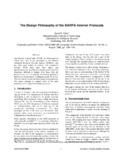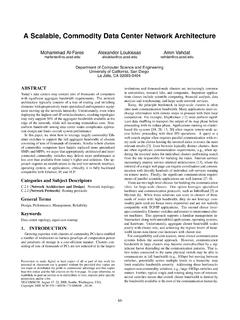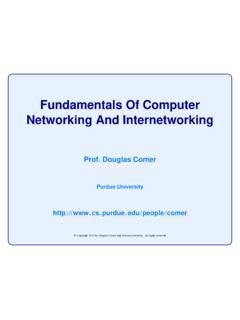Transcription of OpenFlow: Enabling Innovation in Campus Networks
1 openflow : Enabling Innovation in Campus NetworksNick McKeownStanford UniversityTom AndersonUniversity of WashingtonHari BalakrishnanMITGuru ParulkarStanford UniversityLarry PetersonPrinceton UniversityJennifer RexfordPrinceton UniversityScott ShenkerUniversity of California,BerkeleyJonathan TurnerWashington University inSt. LouisThis article is an editorial note submitted to CCR. It has NOT been peer take full responsibility for this article s technical can be posted through CCR whitepaper proposes openflow : a way for researchersto run experimental protocols in the Networks they use ev-ery day. openflow is based on an Ethernet switch, withan internal flow-table, and a standardized interface to addand remove flow entries.
2 Our goal is to encourage network -ing vendors to add openflow to their switch products fordeployment in college Campus backbones and wiring believe that openflow is a pragmatic compromise: onone hand, it allows researchers to run experiments on hetero-geneous switches in a uniform way at line-rate and with highport-density; while on the other hand, vendors do not needto expose the internal workings of their switches. In additionto allowing researchers to evaluate their ideas in real-worldtraffic settings, openflow could serve as a useful campuscomponent in proposed large-scale testbeds like GENI. Twobuildings at Stanford University will soon run OpenFlownetworks, using commercial Ethernet switches and will work to encourage deployment at other schools; andWe encourage you to consider deploying openflow in youruniversity network and Subject [Internetworking]: RoutersGeneral TermsExperimentation, DesignKeywordsEthernet switch, virtualization, flow-based1.
3 THE NEED FOR PROGRAMMABLENETWORKSN etworks have become part of the critical infrastructureof our businesses, homes and schools. This success has beenboth a blessing and a curse for networking researchers; theirwork is more relevant, but their chance of making an im-pact is more remote. The reduction in real-world impact ofany given network Innovation is because the enormous in-stalled base of equipment and protocols, and the reluctanceto experiment with production traffic, which have created anexceedingly high barrier to entry for new ideas. Today, thereis almost no practical way to experiment with new networkprotocols ( , new routing protocols, or alternatives to IP)in sufficiently realistic settings ( , at scale carrying realtraffic) to gain the confidence needed for their widespreaddeployment.
4 The result is that most new ideas from the net-working research community go untried and untested; hencethe commonly held belief that the network infrastructure has ossified .Having recognized the problem, the networking commu-nity is hard at work developing programmable Networks ,such as GENI [1] a proposed nationwide research facilityfor experimenting with new network architectures and dis-tributed systems. These programmable Networks call forprogrammable switches and routers that (usingvirtualiza-tion) can process packets for multiple isolated experimen-tal Networks simultaneously. For example, in GENI it isenvisaged that a researcher will be allocated asliceof re-sources across the whole network , consisting of a portionof network links, packet processing elements ( routers)and end-hosts; researchers program their slices to behave asthey wish.
5 A slice could extend across the backbone, intoaccess Networks , into college campuses, industrial researchlabs, and include wiring closets, wireless Networks , and sen-sor programmable Networks could lower the bar-rier to entry for new ideas, increasing the rate of innovationin the network infrastructure. But the plans for nationwidefacilities are ambitious (and costly), and it will take yearsfor them to be whitepaper focuses on a shorter-term question closerto home:As researchers, how can we run experiments inour Campus Networks ?If we can figure out how, we canstart soon and extend the technique to other campuses tobenefit the whole meet this challenge, several questions need answering,including: In the early days, how will college network admin-istrators get comfortable putting experimental equipment(switches, routers, access points, etc.)
6 Into their network ?How will researchers control a portion of their local net-work in a way that does not disrupt others who depend onit? And exactly what functionality is needed in networkACM SIGCOMM Computer Communication Review69 Volume 38, Number 2, April 2008switches to enable experiments? Our goal here is to proposea new switch feature that can help extend programmabilityinto the wiring closet of college approach - that we do not take - is to persuadecommercial name-brand equipment vendors to provide anopen, programmable, virtualized platform on their switchesand routers so that researchers can deploy new protocols,while network administrators can take comfort that theequipment is well supported.
7 This outcome is very unlikelyin the short-term. Commercial switches and routers do nottypically provide an open software platform, let alone pro-vide a means to virtualize either their hardware or practice of commercial networking is that the standard-ized external interfaces are narrow ( , just packet forward-ing), and all of the switch s internal flexibility is hidden. Theinternals differ from vendor to vendor, with no standardplatform for researchers to experiment with new ideas. Fur-ther, network equipment vendors are understandably ner-vous about opening up interfaces inside their boxes: theyhave spent years deploying and tuning fragile distributedprotocols and algorithms, and they fear that new experi-ments will bring Networks crashing down.
8 And, of course,open platforms lower the barrier-to-entry for new few open software platforms already exist, but do nothave the performance or port-density we need. The simplestexample is a PC with several network interfaces and an op-erating system. All well-known operating systems supportrouting of packets between interfaces, and open-source im-plementations of routing protocols exist ( , as part of theLinux distribution, or from XORP [2]); and in most cases itis possible to modify the operating system to process packetsin almost any manner ( , using Click [3]). The problem,of course, is performance: A PC can neither support thenumber of ports needed for a college wiring closet (a fanoutof 100+ ports is needed per box), nor the packet-processingperformance (wiring closet switches process over 100 Gbits/sof data, whereas a typical PC struggles to exceed 1 Gbit/s;and the gap between the two is widening).
9 Existing platforms with specialized hardware for line-rateprocessing are not quite suitable for college wiring clos-ets either. For example, an ATCA-based virtualized pro-grammable router called the Supercharged PlanetLab Plat-form [4] is under development at Washington University,and can use network processors to process packets frommany interfaces simultaneously at line-rate. This approachis promising in the long-term, but for the time being is tar-geted at large switching centers and is too expensive forwidespread deployment in college wiring closets. At theother extreme is NetFPGA [5] targeted for use in teachingand research labs.
10 NetFPGA is a low-cost PCI card witha user-programmable FPGA for processing packets, and 4-ports of Gigabit Ethernet. NetFPGA is limited to just fournetwork interfaces insufficient for use in a wiring , the commercial solutions are too closed and inflex-ible, and the research solutions either have insufficient per-formance or fanout, or are too expensive. It seems unlikelythat the research solutions, with their complete generality,can overcome their performance or cost limitations. A morepromising approach is to compromise on generality and toseek a degree of switch flexibility that is: Amenable to high-performance and low-cost of openflow Switch SpecificationFigure 1: Idealized openflow Switch.








